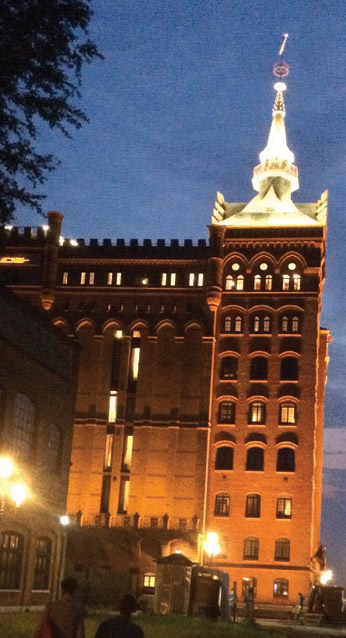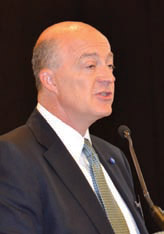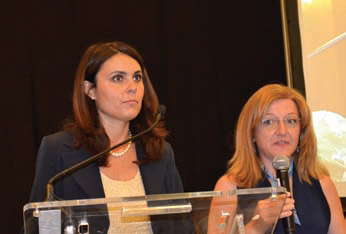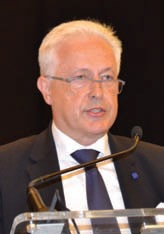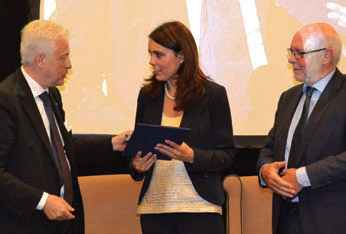Wood at the circle’s centre
26 October 2016The European Panel Federation (EPF) held its annual general assembly in Venice, Italy, this year and Mike Botting joined the delegates to hear about the ‘circular economy’ in relation to the panel products industry
Over 160 delegates attended the EPF’s annual meeting, most coming from the panel manufacturing sector in Europe, plus associate members from supplier companies to that industry. They came from 23 countries, including non-European visitors from India, Singapore and the US.
The theme of the open part of the general assembly was How to reach the circular economy – opportunities for wood based panels and wood based panel furniture products.
The meeting was opened by the chairman of the EPF, Dr Paolo Fantoni, who particularly welcomed Mrs Simona Bonafè, MEP and member of the committee on environment, public health and food safety, with particular responsibility for the Circular Economy Package.
Other important guests recognised by the chairman were: Markus Wiesner, chairman of the Confederation of European Furniture Industries (EFIC) and Jackson Morill, president of the Composite Panels Association (CPA) in the US. Speaking of Venice, Dr Fantoni said “Nice cities attract more participants. More participants offer more opportunities for discussions. Beauty raises the profile of our discussions and our future. Raising the profile of our organisation and shaping the future of our industry is the aim of today.
“Organisations must set targets that cannot be reached by companies alone, so we can reach higher targets. Great organisations like the EPF can thus be both defensive and offensive.
“We believe the EPF should present the excellence of our industry at the public and political level, especially our achievements in environment and sustainable development by, among other things, recycling of wood into great new products.”
Dr Fantoni drew special attention to two Italian panel manufacturing companies – the Frati and Saviola groups – for their pioneering work in developing recycling technologies.
“Today, the debate in the EU is about the ‘circular economy’ and this represents a good opportunity for us with regard to recycling and carbon sequestration,” continued Dr Fantoni.
“It should not any more be accepted that biomass plants are killing wood panel mills, which has led to massive closures and job losses,” insisted the EPF chairman.
The next speaker was Roberto Snaidero, president of Federlegno Arredo of Italy.
“The circular economy will have an evergreater impact on our operations. We’ve already started to work on this with the furniture producers. Recover, re-use and recycle are at the heart of our business.
We are in the front line to ensure that wood plays the leading role in the circular economy. This role must be recognised by national and European institutions.
“We do not deserve these ‘mortal attacks’ where biomass plants are located too close to our production lines. Too many mills have closed or relocated because their wood raw material supply was jeopardised [by biomass plants].
“I am firmly convinced that this is a great opportunity to place wood at the centre of the circular economy,” concluded Dr Fantoni.
Next, Marco Gasperoni, general director of Rilegno (the Italian consortium of packaging and wood waste) spoke on An Italian history of success: The circular economy of wood.
Mr Gasperoni introduced the participants to the Rilegno vision on the circular economy with wood, using a video. It pointed out that Italy is a land of ancient genius, but is poor in wood supply.
This, it said, is the reason why Italy was the first to realise that wood will always be at the centre of the economy and of society.
It began with the sorting of clean wood packaging out of unusable waste materials, whereupon a great recovery and recycling industry was built, thanks to Rilegno and the Italian wood panel industry, without touching a single tree and without burning any matter that is not truly at the end of its life cycle.
The video commentary declared: “There is a new world at our horizon!”
Rilegno is the Italian consortium in charge of wood packaging recovery and recycling, with over 2,300 associates. Members are, among others, producers of particleboard, MDF, pulp, etc.
Mr Gasperoni said that it was the particleboard industry which found the solution by using wood packaging waste on a large industrial scale to produce new products. Thanks to this, he said, the Italian wood industry provides a massive contribution to the EU wood packaging recycling targets, achieving 61% in wood packaging in Italy, whereas Italy overall achieves 35% and the EU target is 15%.
With 8,000 municipalities in Italy, a long and narrow country, with only 12 wood recycling plants, all located in the north of the country, this is where Rilegno was able to assist in very successfully coordinating the collection process for ‘waste’ or ‘urban’ wood, said Mr Gasperoni.
He said there are 400 plants or collection points throughout Italy and that 1.5 million tonnes of wood product 'waste' had been withdrawn and recycled.
Clive Pinnington, managing director of the EPF, then presented the always-eagerly anticipated EPF Annual Report for 2015/16.
He presented a graph which showed that industrial confidence in the EU countries had grown since late 2012 up to May 2016 and said “We’re very excited about this. There was contrasting confidence between consumer and construction, but improvements were seen in the first quarter of 2016.”
Going on to look at individual panel products’ performance in 2015, the managing director began with particleboard.
“Particleboard production increased by 1.5% – on a large volume – and this is encouraging. Germany was the largest market, followed by France and Poland.
There is a general feeling that the particleboard market is ‘stable’,” said Mr Pinnington.
“At 11.8 million cubic metres, MDF was up 2.7% in 2015 and on this large volume, that is a satisfactory result.”
The first three places in MDF production were taken by Germany, Poland and Italy. Consumption of MDF rose by 1.9% in 2015, reported the MD, and Germany was the largest consumer, with the UK second and Poland third.
“The market indicators suggest that the outlook is more optimistic for MDF than for particleboard in 2016.”
The production of OSB increased by 3.9% in 2015, with the biggest capacity producers being Germany, Romania, Latvia and the Czech Republic. Here again, the market indicators were positive for 2016.
Hardboard stood out with an increase in production (excluding Russia) of 9% in 2015, to 616,000m3, though production in the first part of 2016 appeared to be decreasing.
Sales in Europe rose by 10%, said Mr Pinnington.
“Meanwhile, softboard production rose by 10% – the strongest growth of any panel type,” he said.
Plywood production in the EU28 plus Switzerland rose by only 1% in 2015, to 2.8 million m3, but a better, 3.5%, growth is forecast for 2016.
The breakdown of plywood production by country in 2015 put Finland way in the lead at 41%; the Baltic States at 12%; Spain 10%; Italy 9%; Poland 7%; Sweden 3%; Romania 2%; and ‘other’ 6%.
Over all panel types, Mr Pinnington said that the total production was 53.8 million m3, representing an increase in 2015 over 2014 of 3%.
“However, wood availability in many European countries is assessed as ‘critical’! That is one of the extreme challenges that our industry faces today.”
Mr Pinnington then set out the EPF’s three main objective categories for 2016: “The basics: ‘Meet’ is to make a concrete achievement on our five new cornerstone policies; to gain new members, especially from the plywood sector; and to recruit an economic adviser and enhance the EPF secretariat.
“Next come the Essentials: ‘Defend’: Formaldehyde OEL at 0.3ppm via CMD and/ or SE (REACH); and a VOC class concept. “Thirdly, Future: ‘Grow’ to position wood based panels in the centre of the energy, climate and industry debate; and to adopt the ‘cascaded use of wood’ principle into a Circular Economy package.
These are the two huge topics which we have to address,” said Mr Pinnington, adding that a third objective is to enlarge the MEP Club du Bois under chairwoman MEP Ms Maria Noichl.
“It was an extreme goal to get cascaded use of wood included in the EU documents and we succeeded!” said the EPF MD.
“There is much more to do and the hard work starts now!”
Following Mr Pinnington, Karmenu Vellu, EU Commissioner for environment, maritime affairs and fisheries, presented by video on his theme of How to reach the circular economy.
“The circular economy offers gains for business, society and the environment and we have pledges from industry to use recycled products. There is an obligation to employ cascaded use of materials when appropriate and cost-effective, to keep the value of materials in the system for as long as possible. I am doing all I can to see that ‘Post 2020’ [legislation] contains the cascaded use of wood.
“Wood should be a ‘poster child’ for the circular economy……your industry is already leading the way,” concluded Mr Vellu.
Shaping the future of the board industry: The cascading use of wood in the circular economy was the presentation that brought Dr Fantoni back to the rostrum.
The chairman gave an update of the EPF targets: “To accept the compulsory adoption of the E1 emission limit and to pursue this through the EU; to adopt a definition of the new emission levels with a new standard with common ground between EU and US panel producers; to increase the appearance of our products in buildings; to form a new vision of operations with Africa.
“Our products may be simple, but they embody a lot of technology which we could share with Africa. I propose an organised meeting to demonstrate European test methods,” added the chairman.
“Our second main target is to achieve a new perception of our industry by the public. We have been seen as negative for the environment for a long time and I want us to engage in changing this perception and to encourage our members to do this. “It is one of the great challenges of this century to reduce CO2 emissions, and we can play a big part in this.”
Turning to the subject of energy generation, Dr Fantoni said “I am very disappointed when I see a large coal-fired energy plant, for example, converted to use wood chips. There are approximately 10 million tonnes of wood chips imported to Europe from North America and that figure is expected to rise to 20 million tonnes by 2020. This shows that European wood resources are not sufficient and puts even more price pressure on our supplies. We also want to stop wood going to landfill. ‘Use, recycle and finally, burn’,” said the chairman.
“We have two main objectives here: For the EC to encourage the use of wood and not to give subsidies that act against our industry (I don’t mean no subsidies at all). The second objective is to achieve cascaded use of wood. We suggest to the legislators that they see the plans already operating in Belgium, where Fedustria already applies cascaded use of wood by law and subsidies are only given if the wood based panel industry can’t, or doesn’t want to, use the material. This should be replicated all over Europe,” concluded Dr Fantoni.
Markus Wiesner supported Dr Fantoni in this, saying that if we support the principles of a circular economy then we have to re-use and recycle. “It is very, very important to get the maximum effect and the furniture industry is ready – we very much support the [upcoming] Declaration.
Principle Guest
The ‘star of the show', MEP Mrs Bonafè, then took to the rostrum:
“Here are some facts,” she said:
- We consume two and a half times the resources that the planet can create
- We either change the model or come to terms with the limits of the planet
- The good use of raw materials is not just an environmental issue, but an economic issue as well – this is important;
- We must move away from consumption and throwing away to a circular economy; the circular economy is the only industrial policy that puts together development and sustainability; we need clear rules to accompany this process
- The package will be approved by the EU Parliament by the end of 2016.”
Mrs Bonafè went on to say that, in the Parliament, a lot of discussion had focused on targets and that we need targets to make the proposal work.
“I want us to recycle 70% of waste and 80% of packaging by 2030, with 80% of wood and wood packaging recycled.
“I also want it to be compulsory for every country to collect [used] wood. I also believe that we should extend producer responsibility to all flows – and of course wood.
“We’ve started walking and must continue in this direction: This [circular economy] is the economy of the future.”
Following Mrs Bonafè’s presentation, the Venice Declaration was signed by Dr Fantoni and Mr Wiesner and presented to her
The circular economy: an opportunity for the industrial wood sector was the subject of the next presentation, given by Mr Carlo Maria Medaglia, technical head of the Italian Environment Ministry.
He said that the circular economy is a vital topic for the Italian Government. “For Italy, the circular economy is not just the vital path, but it is the ONLY path for the future. This is especially important in view of the fact that Italy still has substantial land-filling, which must be reduced.
“We should widen the scope and not only talk about waste, but also about bioeconomy, GPP, harmful environmental subsidies and a huge amount of topics of which ending waste is only a part,” said the speaker.
The final presentation was from David Borrelli, MEP and member of the Club du Bois. He is also on the Industry, Research and Energy Committee.
“I started with the circular economy 11 years ago, when I began my political career, with the conviction that waste is a resource that should be recycled and transformed,” he said. “I am very glad to see this EU initiative for the future of the industry, the economy and the environment.
“It is important for us MEPs to understand your problems in your daily work. It is too easy to lose touch with reality and this kind of collaboration helps.
